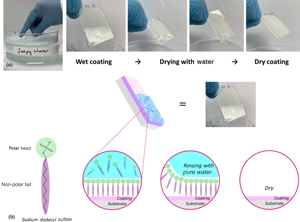Article contents
Organic superhydrophobic coatings with mechanical and chemical robustness
Published online by Cambridge University Press: 06 May 2020
Abstract

Stable superhydrophobic coatings were produced from aqueous suspensions of epoxy nanoparticles. The superhydrophobic coatings demonstrated excellent mechanical robustness and chemical resistance. Aqueous solutions of ionic surfactants, nonionic surfactants, and small organic molecules on superhydrophobic coatings could wet the superhydrophobic coatings. However, the superhydrophobicity can be recovered by rinsing the wet surface with water. It was also discovered that, although seemed wetted, the superhydrophobic surface was separated from the solution of ionic surfactant by a layer of ionic surfactant molecules. In contrast, nonionic and small organic molecules could not aggregate on the superhydrophobic surfaces; the coatings were exposed to the solutions.
- Type
- Research Letters
- Information
- Copyright
- Copyright © Materials Research Society, 2020
References
- 6
- Cited by




